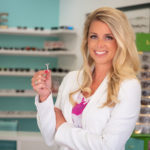
Dr. Wruble says scleral lenses have given her a chance to change patients’ lives and grow a profitable practice niche.
By Rachael Wruble, OD, FAAO
Nov. 2, 2022
For the sake of my father and three aunts with keratoconus, I knew in optometry school that I needed to become proficient in specialty contact lenses. I completed a residency at a VA hospital clinic, where I had the opportunity to fit scleral lenses on veterans who had ocular trauma. It gave me a chance to see the life-changing effect of patients going from 20/200 to 20/20 just by inserting a lens.
Eleven years after I began fitting scleral lenses, I’ve gone from fitting one pair every three months to fitting them every day. At the five clinics I co-own, three associate doctors have taken an interest in fitting scleral lenses as well, after seeing their immediate impact and ability to improve patients’ quality of life. When I started a practice with my partner, I didn’t know anything about scleral lens costs or reimbursements—I only knew the amazing results—but through the years, I’ve found that scleral lenses can be a significant financial benefit to the clinic.
How to Get Started
Setting up a scleral lens clinic is affordable. I started out with a slit lamp, a phoropter and an inexpensive scleral set that I bought in school. As I got more involved, I purchased a good topographer and anterior OCT.
Scleral Lens Education Initiative
Click HERE to visit a page devoted to the Scleral Lens Education Initiative, where you will find resources for everything from the history and basics of getting started with scleral lenses to all the information and resources you need when working with them.–ROB Editors
Be prepared to schedule lens fitting visits for a little longer than a standard refraction (try 2-3 standard time slots to start). It means you’ll see 1-2 fewer patients that day, but it’s worth it to gain the experience, and you’ll get faster with practice. Also, those patients become “forever” patients based on the time you spend and the success you will achieve with them.
You should also consider which patients you want to treat with scleral lenses. In a multi-center survey published last year, 74 percent of scleral lenses were prescribed for corneal irregularity, 16 percent for ocular surface disease and 10 percent for uncomplicated refractive error.1
I started out fitting patients with irregular or scarred corneas, and that’s still my most common reason for fitting sclerals. But now I also use them in my dry eye clinic. TFOS DEWS II has recommended scleral lenses as stage 3 dry eye therapy before punctal occlusion or amniotic membrane grafts.2 Sclerals hold in moisture and lubricate the eye while reducing fluctuating vision. My dry eye patients describe them as “life-changing,” just like my patients with corneal scarring.
Teach your staff all about scleral lenses, so they can help with these patients. Our technicians teach insertion and removal, and we’ve had all of them wear sclerals, so they can understand the comfort and the experience of putting them in and out.
Don’t be afraid to tell candidates that you have a new lens, and you want them to be among the first to get it, but the fitting will take a while because you’re building experience. Finally, in addition to identifying candidates in your practice and adding scleral lenses to your list of dry eye treatments, you can get scleral lens referrals from your referring ophthalmologists as well as local rheumatologists.
Fitting and Patient Education
My fitting process is simple. Every patient gets topography. I choose the best scleral lens fitting kit for the individual patient, based on the corneal integrity and ocular history. Zenlens (Bausch + Lomb) is great for post-refractive and keratoconus cases. Europa Scleral (Visionary Optics) has worked well for my dry eye patients. I put the lenses on and assess the fit, from central clearance to edge lift, and then assess the fit further with anterior OCT. Finally, I over-refract to get the prescription we want.
When the first custom set of lenses is ready, the patient comes back so we can check the fit and vision. If everything looks good, vision is clear and the lens feels comfortable, then patients meet with a technician who trains them in insertion and removal, lens care and using the recommended solutions.
Other Articles to Explore
We give patients a card with our recommended products and where to buy them, as well as a brochure showing insertion and removal techniques. For example, we have patients use preservative-free drops to fill the contact lens bowl before placing it on the eye. There are several options, including iVIZIA (Thea), LacriPure (Menicon) or PuriLens Plus (LifeStyle). We’ve been using iVIZIA for many dry eye patients, including contact lens wearers, for its unique formulation of povidone, trehalose and hyaluronic acid. Its multi-dose preservative-free bottle design allows patients to use a single, easy-to-use bottle rather than individual ampoules.
Patients really like how their eyes feel hydrated throughout the day. We often recommend Unique pH (Menicon) for cleaning because it won’t strip the coating used on most lenses. Any time patients’ eyes feel dry, they can use more iVIZIA drops or Blink-N-Clean (Johnson & Johnson Vision).
When we put scleral lenses on the eye, some patients don’t feel them, but others might feel the edges or think that insertion and removal feel strange. We have them wear the lenses for one week and come back. The lenses are usually feeling fine and patients are raving about their vision, so we don’t need to see them again until their annual exam. We tell patients upfront that we might need to make multiple adjustments, and that’s fine—we want to get it just right.
Scleral Lens Profitability
We bill patients for the corneoscleral fit and scleral lenses. It includes up to 90 days of follow-up, but we’re usually done in a few weeks.
Reimbursement for scleral lenses is reliable, but there’s a slight learning curve. In my practice, I know that three vision insurance companies will reimburse scleral lenses. Others do not, but in many of those cases, we can use the patient’s medical insurance with prior approval. This is even true for dry eye disease because the FDA has approved scleral lenses for keratoconjunctivitis sicca. We document thoroughly so we can provide the details that insurers want.
Depending on the case and the type of insurance, reimbursement can range from $1,600 to $3,000. In a month, I see about 12 scleral lens cases, and my associates are seeing about one per week as they continue to build their scleral base.
These patients are also buying their regular glasses, and, in some cases, a second pair to wear over their contacts for night glare or optimal vision at all distances. Patients getting sclerals for dry eye also get other therapies, such as intense pulsed light, radiofrequency treatment, amniotic membrane and punctal plugs. Most importantly, these people become lifelong patients because we change their lives. It’s awesome to see them light up in their new scleral lenses.
References
1. Kawulok E, Schornack M, Nau CB, Guier C, Wentz C. Multicenter Review of Indications for Scleral Lens Wear. Invest Ophthalmol Vis Sci. 2021 Jun;62(8):676. https://iovs.arvojournals.org/article.aspx?articleid=2774485
2. Jones L, Downie LE, Korb D, et al. TFOS DEWS II Management and Therapy Report. Ocul Surf. 2017 Jul;15(3):575-628. doi: 10.1016/j.jtos.2017.05.006.
 Rachael Wruble, OD, is co-owner and chief financial officer at Belmont Eye and Northlake Eye, with locations in Asheville, Belmont, Concord and Charlotte, North Carolina. She is Past President of the North Carolina Optometric Society.
Rachael Wruble, OD, is co-owner and chief financial officer at Belmont Eye and Northlake Eye, with locations in Asheville, Belmont, Concord and Charlotte, North Carolina. She is Past President of the North Carolina Optometric Society.

























